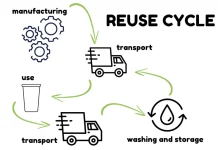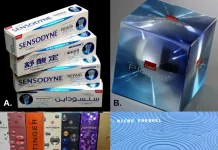by Helen Rallis, field product manager – Coatings, Sun Chemical
 In many ways, consumers are changing their shopping experience. Online shopping and the use of smartphones have made it easier to obtain products with a simple touch of a button. However, while this is true for many retail purchases, people still frequent grocery stores, and studies show this behavior won’t change any time soon.1 So, the grocery store still represents a good location to showcase a product.
In many ways, consumers are changing their shopping experience. Online shopping and the use of smartphones have made it easier to obtain products with a simple touch of a button. However, while this is true for many retail purchases, people still frequent grocery stores, and studies show this behavior won’t change any time soon.1 So, the grocery store still represents a good location to showcase a product.
This is not an easy task. Today’s grocery store has about 1,700 brands, and people are pressed for time when they are shopping. It is a difficult landscape for someone who is trying to sell a product, as only about 10% of the shelved products attract a shopper’s attention as the individual passes through the store. The key is to attract attention and interest. Studies show that 70% of the packages that are picked up and evaluated in the store are purchased.2
Many package designers use special effects coatings to enhance their products and promote consumer interaction. People link the look and feel of a package to the product inside. According to “Brand Sense” by Martin Lindstrom, successful brands use strategies to integrate packaging that appeals to all five senses. This helps create emotional engagement and attachment to the product.3
Top Special Effects Trends
 Matte coatings
Matte coatings
Matte coatings help dull the glare of overhead lights and allow a shopper to better see graphics on a package. They can impart the look of velvet, leather or paper. When used in combination with a high-gloss coating, it is possible to create a 3D look that “pops.”
Matte coatings are available in many types of chemistries, but the energy-cured products tend to be the most resistant to mars and scuffs. This is one of the most widely used effects because no special equipment is required. The desired effect can be obtained using a 6 to 10 BCM (billion cubic microns) volume anilox roller, which is commonly found in most print shops.
However, care must be taken when printing these coatings. The product must be thoroughly mixed before being brought to press, as the matting agents tend to settle to the bottom of the container over time. Also, keep an eye out for foaming, as this can cause a viscosity build-up over time.
Paper feel coatings
Combine a matte coating with a sandy, rough texture, and the result is a coating that looks and feels like paper. Brand owners are requesting this type of product to convey the idea that their product is made from natural ingredients, or that extra care was used in the manufacture of the product and it is “homemade,” while still being able to provide the barrier properties that come from using a film lamination. If done correctly, the added haptic effect really brings out the intended sensory effect and appearance.
Different textures are available for this type of coating, from fine grit to a coarse, sandpaper feel. As a result, the aniloxes recommended will vary, depending on the particle size and level of effect required. The most common aniloxes used to apply these types of coatings are in the 25 to 30 BCM range.
Soft Touch
Soft-touch coatings create a matte surface that feels soft to the touch. It can feel like velvet or like leather. These are available for a wide variety of substrates but are most commonly used on paper. The feel of these coatings can be very subjective. Therefore, it is important to test the effect on the correct substrate and obtain customer approval before the live run. Also, it is important to check with the coating supplier for handling instructions, as some of the chemistries are unique and require special washing.
Application thickness is dependent on substrate absorption. For a nonabsorbent substrate, such as polyester film, less application is needed than on paper or board. For film, the use of 5 to 10 BCM and a hard, sticky-back tape on the printing plate will give a smooth, soft surface. For paper, 10 to 15 BCM is recommended.
Glitter and pearl
Glitter and pearl images and effects have been used to create truly innovative designs. Glitter coatings, as the name implies, sparkle like gems. Pearlescent coatings are iridescent and produce shimmering effects. In some cases, pearlescent pigments produce a color shift, depending on the viewing angle. Hundreds of different colors and many particle sizes are available, from 10 microns to 200 microns. Most of the pearls used for packaging range from 10 to 50 microns and can be applied using 10 to 20 BCM aniloxes. The glitter particles, in general, vary from 50 to 200 microns. It is recommended to start with a 25 to 50 BCM anilox and higher for these types of coatings.
Design and End-Use Considerations
 When designing with special effects, a few factors should be taken into account. The first is the amount of coating used in the design. Flood-coating the specialty coating may not necessarily give the best effect. Sometimes, a simple highlight can attract the eye. Also, using a dark background can help to provide contrast and make these effects stand out more.
When designing with special effects, a few factors should be taken into account. The first is the amount of coating used in the design. Flood-coating the specialty coating may not necessarily give the best effect. Sometimes, a simple highlight can attract the eye. Also, using a dark background can help to provide contrast and make these effects stand out more.
It is important to make sure the final product will work in the intended application when designing the package. Flexible packaging and folding cartons must survive the filling and transportation process before landing on a grocery shelf, so the coatings must be able to pass certain scuff and friction tests.
Coatings used on food products must be formulated to be low odor and fast curing so that food flavors are unaffected. Coatings used on primary food packaging also must be tested for migration, so it is important to discuss the end-use properties at the forefront with the coating supplier so these issues are addressed. The more successful endeavors are collaborative.
Equipment
 In recent years, converters have started to use flexo equipment to apply special effects coatings as equipment manufacturers have worked toward getting coaters and aniloxes that deposit more coating onto substrates. Generally speaking, these special effects coatings require an anilox with cell openings that are twice as wide as the average particle size of the pigment being used in the formula. This allows the coating to flow in and out of the cells easily and transfer onto the printing plate.
In recent years, converters have started to use flexo equipment to apply special effects coatings as equipment manufacturers have worked toward getting coaters and aniloxes that deposit more coating onto substrates. Generally speaking, these special effects coatings require an anilox with cell openings that are twice as wide as the average particle size of the pigment being used in the formula. This allows the coating to flow in and out of the cells easily and transfer onto the printing plate.
While the printer might need to invest in a number of diverse aniloxes to do this type of printing effectively, equipment has evolved so that changing aniloxes has become easy and fast. The key to success is being willing to experiment and bring in everyone involved, from designer to printer to supplier, at the beginning of the process.
Additional equipment considerations exist as well. Because higher volume aniloxes are being used, it is important to make sure enough coating is flowing through the press at all times. The hose diameters need to be wide enough to accommodate the extra coating so the anilox does not get starved. Also, the pumps need to be strong enough to keep up with the volume demands. Finally, since many of these coatings contain large, heavy pigments, they often require constant mixing in the sump to keep the coating uniform over the course of the run.
Conclusion
More brand owners are exploring the use of special effect coatings on their packaging in an effort to attract attention to the product and promote interaction and involvement. With some advance planning and experimentation, printers can provide unique and exciting printed packaging to their customers.
Helen Rallis has more than 20 years of expertise with flexible packaging coatings and currently works as a field product manager for coatings at Sun Chemical. For more information, visit www.sunchemical.com/naicoatings or call 708.236.3798.
References
- Nielsen Global E-Commerce and The New Retail Report, April 2015.
- Point of Purchase Advertising International (POPAI) – The Global Association of Marketing Retail & Nielsen Reports/Trends.
- Brand Sense, Sensory Secrets Behind the Stuff We Buy, February 2010, Martin Linstrom.






